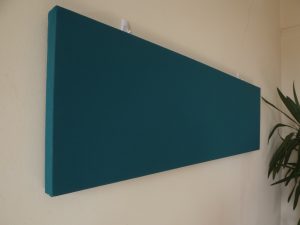Last update: October 2021
Here the term ‘sound canvas’ is defined as a device that consists of a compact sound system within a defined surface, made to stand vertically on walls, resembling a traditional canvas painting. Sound (via small speakers or other means) is fundamental, but it can also include various materials, such as printed or painted images, lights and sensors for interactivity. In addition, multiple speakers can be set on the surface and configured for spatial audio, allowing the art space to become a three-dimensional sonic space. This approach offers a range of possibilities to the field of composition and sound art, as it can be representative (e.g., soundscapes), performative, interactive or conceptual.
Endless approaches can be taken to express art and sound through this format. For instance, sounds can be spatialised to different angles of a canvas and by utilising techniques of sound localisation and cinematic stereophony, an illusion of sound navigating through space can be achieved. Multisensory works can be achieved by combining sound with LED lights and other materials.
Since 2014, sound canvasses have been produced and presented at sound art conferences and exhibitions. The work has progressed through two main design stages:
1) 2014-2017: Musical Painting (electronics and speakers are covered by fabric)
2) 2018-2021: Sound-Light Canvas (electronics and speakers are visible and enclosed within a frame; sound and light interaction is imperative)

Two sound canvasses exhibited at the Threshold Festival 2017

Belt of Orion (2021)
Catalogue of sound canvasses:
2021 – Belt of Orion (3 channels, 65x35cm)
2021 – Pulsar (2 channels, 34.9×29.8cm)
2019 – Sound Scroll: Lyra Constellation (6 channels)
2018 – Sound Scroll: Lotus Sound (6 channels)
2017 – Sound Lines #2 (4 channels, 30 LED lights, 30 sensors, 40.5x91cm)
2017 – Sound Lines #1: The Earth’s Orbit (2 channels, 30 LED lights, 80x30cm)
2017 – Sounds from Bali & Sounds from Gili Meno (2 channels, 80x30cm)
2017 – Stereo Space for Rhythmus 21 (2 channels, 40.5×25.5cm)
2017 – University Poster (6 channels, 100x76cm)
2017 – Battistero, Voci della Terra e del Cielo (3 channels, 91x71cm)
2017 – Bi-dimensional (6 channels, 100x35cm)
2017 – The Seashore (4 channels, 117×35.5cm)
2017 – Spatial Poetry #2 (4 channels, 50x40cm)
2017 – Collage #2 (8 channels, 100x75cm)
2016 – Spatial Poetry#1 (2 channels, 30x25cm)
2014 – Collage #1 (8 channels, 100x70cm)
Featured Pieces
Belt of Orion (2021, 3 channels, 32 LEDs, 65x35cm)

Belt of Orion is a sound canvas portraying the three central stars of the constellation of Orion: Alnitak, Alnilam and Mintaka. This asterism is visible worldwide and has been associated with various religious and mythological trinities in different cultures. Here, three loudspeakers symbolise this celestial line of stars in an environment that blends sound, light and space, where kinetic patterns shift throughout the canvas and construct a multisensory discourse.
Pulsar (2021, 2 channels, 7 LEDs, 34.9×29.8cm)
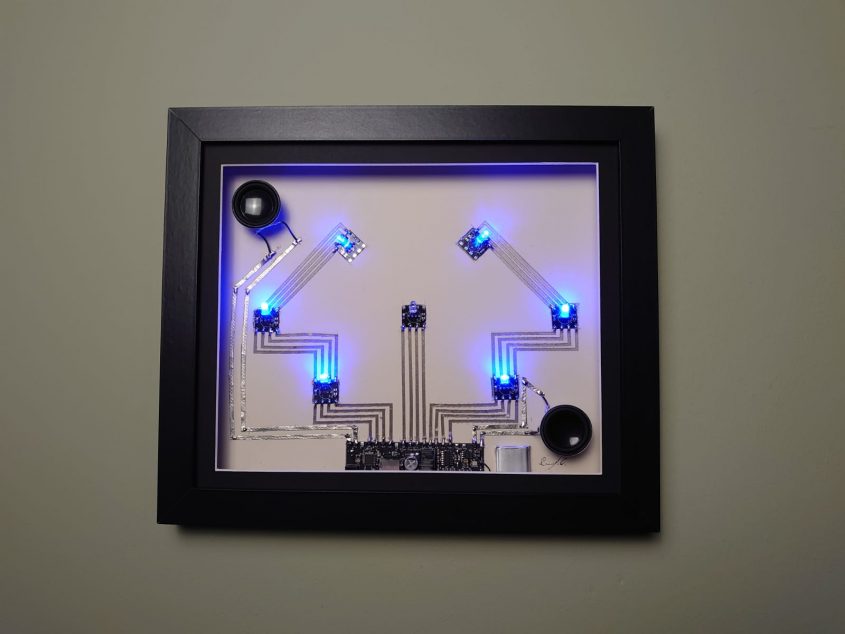
Pulsar is an abstract environment within a frame that blends circuit design, music composition, light and sound spatialisation techniques. The music, designed with granular/pulsar synthesis, has three sections for a total length of c. 1’45”.
An innovative sound panning technique was used (circular depth) to synchronise a three-dimensional sound with lights, suggesting the rotation of a pulsar (a neutron star that rotates light beams).
Sound Lines #2 (2017, 4 channels, 30 LEDs, 30 sensors, 91×40.5cm)
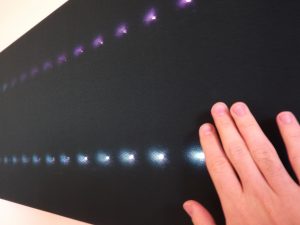

This piece explores a new approach to interactive spatialisation. While an electronic composition is performed, the listener can control the stereophonic position of two lines of sound through in-built LDR sensors. The result is a quadraphonic system that includes LED lights, 15 for each line, indicating the current sound position.
Sound Lines #1: The Earth’s Orbit, (2017, 2 channels, 30 LEDs, 80x30cm)

The Earth’s Orbit represents the frequency of the Earth’s rotation around the sun, multiplying it by many octaves to find a related audible frequency and a related panning frequency. 30 LED lights display the sound trajectory in synchrony with the panning effect.
The Seashore (2017, 4 channels, 117×35.5cm)
The Seashore is a 3D soundscape simulation in which sea waves break into the centre of the canvas, and the swash and backwash shift downwards and upwards.
Bi-dimensional (2017, 6 channels, 100x35cm)

This piece is a mixture of a pre-recorded composition and user interaction. In some sections, the painting performs a spatial recording of a surround composition for flute and electronics, while in other sections, it becomes interactive, as sounds and lights are displaced when triggered by sound and pitch detection.
It has been recently exhibited at the Threshold Festival 2017.
Battistero, Voci della Terra e del Cielo (2017, 3 channels, 91x71cm)


The painting displays an image of the exterior of the Pisa Baptistery and conceived inside there is a multichannel circuit with three loudspeakers, two in the lower part and one in the superior part of the panel. The loudspeakers at the lower region correspond to the audio of the ground level, while the superior loudspeaker correspond to the audio captured from the superior level, thus redimensioning the actual acoustic space to an acoustic reduction. Through this method of reproduction, it is possible to perceive the sonority difference between levels through a divergent perspective.
Click here to know more about it!
University Poster, (2017, 6 channels, 100x76cm)
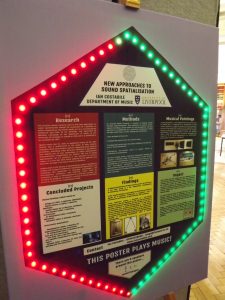
Poster presentation at the PGR Showcase at the University of Liverpool, June 2017
Made especially for the Postgraduate Showcase at the University of Liverpool, this is probably the only musical poster in the world. Sounds navigate around the canvas in a hexagon shape. The LED lights follow the sound trajectory. This poster won the Academic Jury Prize.

Internal structure (seen from the inside)
watch the video on: https://www.youtube.com/watch?v=fnMFH1WjQbE&t=18s
Sounds from Bali & Sounds from Gili Meno (2017, 2 channels, 80x30cm)


These two paintings represent unique recordings of Indonesia, including soundscapes of clinking fossils in a coral reef, croaking frogs in tropical forests, flocks of pigeons flying with bells, in addition to some other sounds recorded in August 2017. The visual patterns displayed are authentic batik fabrics made in Indonesia.
Collage #1: Frozen Night (2014, 8 channels, 100x70cm)
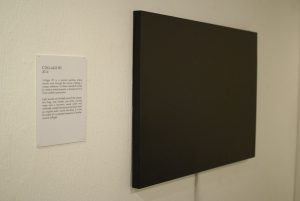
Collage #1 is an eight-channel soundscape comprised mainly of recordings of insects, which were processed to sound static or quasi-static. It creates a virtual scenario, a simulacrum of a forest auditory panorama. Eight sounds are located in different positions around the canvas: two frog sounds, two cicada sounds, three bird sounds and the sound of running water.
This piece was first exhibited in the Static Music exhibition in 2014.
Publications / Articles / Conference Papers:
2019 – Kinetic Sound Art and the Sound Canvas (ISBN 978-88-944350-0-9)
2018 – Lotus Sound: A Hanging Sound Scroll
2017 – Framing Spatial Music
2017 – Site-Specific Composition for the Pisa Baptistery

